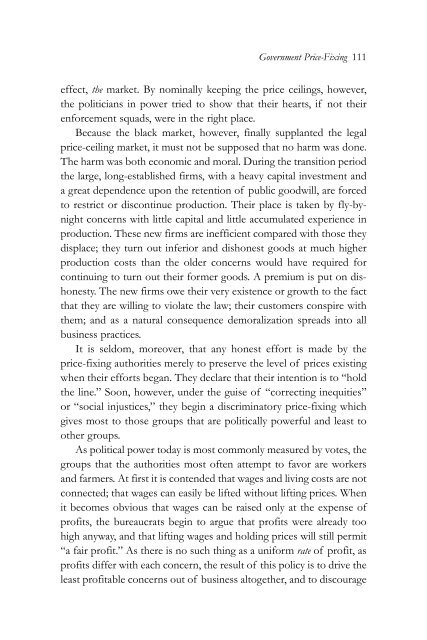1gDdM7w
1gDdM7w
1gDdM7w
- No tags were found...
You also want an ePaper? Increase the reach of your titles
YUMPU automatically turns print PDFs into web optimized ePapers that Google loves.
Government Price-Fixing 111effect, the market. By nominally keeping the price ceilings, however,the politicians in power tried to show that their hearts, if not theirenforcement squads, were in the right place.Because the black market, however, finally supplanted the legalprice-ceiling market, it must not be supposed that no harm was done.The harm was both economic and moral. During the transition periodthe large, long-established firms, with a heavy capital investment anda great dependence upon the retention of public goodwill, are forcedto restrict or discontinue production. Their place is taken by fly-bynightconcerns with little capital and little accumulated experience inproduction. These new firms are inefficient compared with those theydisplace; they turn out inferior and dishonest goods at much higherproduction costs than the older concerns would have required forcontinuing to turn out their former goods. A premium is put on dishonesty.The new firms owe their very existence or growth to the factthat they are willing to violate the law; their customers conspire withthem; and as a natural consequence demoralization spreads into allbusiness practices.It is seldom, moreover, that any honest effort is made by theprice-fixing authorities merely to preserve the level of prices existingwhen their efforts began. They declare that their intention is to “holdthe line.” Soon, however, under the guise of “correcting inequities”or “social injustices,” they begin a discriminatory price-fixing whichgives most to those groups that are politically powerful and least toother groups.As political power today is most commonly measured by votes, thegroups that the authorities most often attempt to favor are workersand farmers. At first it is contended that wages and living costs are notconnected; that wages can easily be lifted without lifting prices. Whenit becomes obvious that wages can be raised only at the expense ofprofits, the bureaucrats begin to argue that profits were already toohigh anyway, and that lifting wages and holding prices will still permit“a fair profit.” As there is no such thing as a uniform rate of profit, asprofits differ with each concern, the result of this policy is to drive theleast profitable concerns out of business altogether, and to discourage


